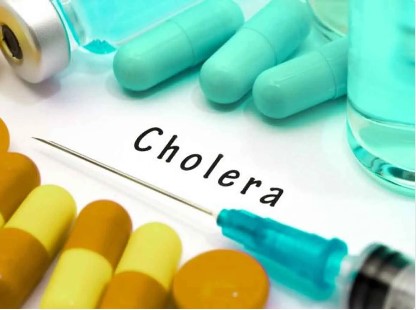Health
Meningitis, Cholera Kill 88, Experts Call For Action
Published
2 years agoon
By
Editor
A total of 922 cholera cases have so far been recorded in Nigeria and 32 of them succumbed to the disease in 2023.
This is according to the latest situation report obtained from the World Health Organisation.
The Case Fatality Rate is at 3.5 per cent as of March 5, 2023.
The WHO noted that the data include the suspected positive rapid diagnostic tests and laboratory-confirmed cholera cases.
It said the case and death numbers presented are unreliable due to differences in reporting systems and underreporting.
Cholera is an acute diarrheal illness caused by infection of the intestine with Vibrio cholerae bacteria. People can get sick when they swallow food or water contaminated with cholera bacteria. The infection is often mild or without symptoms, but can sometimes be severe and life-threatening.
READ ALSO: Africa Records 26,000 Cholera Cases, 660 Deaths In January – WHO
As of March 20, 2023, at least 24 countries continue to report cholera cases. With reference to historical transmission patterns and seasonality, large parts of the world are currently in low or interepidemic transmission periods, therefore this number could increase in the months to come.
The mortality associated with the outbreaks is of particular concern as many countries reported higher case-fatality ratios than in previous years.
Also, the situation report obtained from the website of the Nigeria Centre for Disease Control and Prevention showed that there were 157 confirmed cases of meningitis in the country from October 2022 till March 5, 2023.
A total of 628 suspected cases of meningitis, including 52 deaths, have been reported from 21 states and 66 Local Government Areas in the country.
Meanwhile, the CFR stands at 8.3 per cent.
Meningitis is an inflammation of the meninges, a thin layer of the connective tissue that covers the brain and the spinal cord. The common signs and symptoms are fever, headache, nausea and vomiting, neck stiffness, and altered consciousness level.
READ ALSO: Cholera Outbreak: 19 Dead, 286 Others Hospitalized In C’River
The report read in part, “Age group 5 -14 years was the most affected age group. Males were 62 per cent, females were 38 per cent.
“Ninety-One per cent of all cumulative cases were from four states – Jigawa (509 cases), Bauchi (23 cases), Zamfara (22 cases), and Oyo (14 cases).
“Ten LGAs across five states, Jigawa (7), Bauchi (1), Oyo (1), Plateau (1) and Zamfara (1), reported more than five cases each this CSM seasons 2022/2023.”
A medical laboratory scientist at the Department of Microbiology, Nnamdi Azikiwe University Teaching Hospital, Nnewi, Anambra State, Obinna Chukwudi expressed worry over the country’s poor preparedness in tackling disease outbreaks.
“The Cholera and Meningitis outbreaks in recent times give a clear picture of the degree of our preparedness and containment strategies for more dangerous emergency disease outbreaks in the future.
“The government on the other hand is not left behind because judging from the aetiology of these diseases, you will notice that it is more of the socio-economic levels of the people which put them at a higher risk of getting infected. I advise that the government with advice from experts in the health system should intensify its approaches to implementing more policies that would better the health and well-being of the people.
READ ALSO: Nigeria’s TB Case Finding Rises By 50%, Says WHO
“A multifaceted approach including public policy, surveillance, water purification and hygiene, community sensitisation, and the use of vaccines is vital to prevent, control, and reduce cholera and meningitis menace in the affected states,” he said.
Also, the Ondo State Epidemiologist, Dr. Stephen Fagbemi said there is a need for joint efforts between the government and the people to fight diseases.
“The government and the people need to work together. There is a need for increased awareness and people need to report to the hospitals once they notice the symptoms.”
PUNCH
You may like


A’Ibom Confirms Cholera Outbreak, Begins Campaigns


Cholera Kills Nine In Rivers


JUST IN: 10 Die Of Fresh Cholera Outbreak In Ebonyi Cholera


JUST IN: Nigeria Records 63 Deaths, 2,102 Cholera Cases


[JUST IN] Cholera Outbreak: Lagos Records 29 Deaths, 579 Suspected Cases


Lagos Cholera Cases Rise To 421
Health
LASG FLags Off Polio Outbreak Response Campaign
Published
6 months agoon
January 20, 2025By
Editor
The Lagos State Government, through the Lagos State Primary Health Care Board, has launched the 2025 Polio Outbreak Response Campaign, reaffirming its commitment to eradicating polio and safeguarding the health of its children.
The ceremony, held at the Simpson Primary Healthcare Centre, was led by the First Lady of Lagos State, Dr. (Mrs.) Claudiana Ibijoke Sanwo-Olu, represented by Mrs. Widad Jumoke Mustafa, a member of the Committee of Wives of Lagos State Officials (COWLSO).
In her address, the First Lady emphasised the state government’s proactive measures to keep Lagos polio-free, highlighting the critical importance of the campaign in preventing the debilitating effects of poliomyelitis, which can result in paralysis or death.
READ ALSO: IMPEACHMENT: Lagos Ex-Speaker, Obasa’s ‘Sins’ Revealed
The First Lady also called on parents, community leaders, and stakeholders to support the campaign by ensuring eligible children are vaccinated.
Targeting children aged 0-59 months, vaccination teams will administer the Oral Polio Vaccine (OPV) to prevent virus transmission.
Dr. Kemi Ogunyemi, the Special Adviser on Health, expressed gratitude to Lagosians for their continued cooperation in the fight against polio. While appreciating all healthcare workers and partners for their services, Mrs. Ogunyemi encouraged parents to present their children and wards for the exercise.
Also speaking, the Chairman of Lagos Mainland Local Government, Mrs. Omolola Rashidat Essien opined that Immunization is key in ensuring that children are kept safe from polio and other vaccine preventable diseases.
Dr. Abimbola Bowale, the Supervising Permanent Secretary, Lagos State Primary Health Care Board, who also spoke at the event, underscored the life-saving importance of immunization.
“All children aged 0-59 months need multiple doses of the polio vaccine to ensure full protection. Any child missed represents a potential risk for the poliovirus to spread. The vaccine is safe, effective, and crucial in keeping our communities polio-free,” he stated.
Dr. Bowale also outlined several strategies to ensure the success of the campaign, including fixed post teams stationed at primary healthcare centres and public health facilities, house-to-house visits, and a transit strategy to reach special locations such as places of worship, schools, motor parks, and other public venues.
The event concluded with Dr. (Mrs.) Claudiana Ibijoke Sanwo-Olu officially launched the campaign, marking a renewed effort to maintain Lagos State’s polio-free status.

The Lagos state suspected cholera cases have risen to 421.
The Commissioner for Health, Akin Abayomi disclosed this on his Instagram handle @profakinabayomi on Saturday.
“As of June 20, 2024, an additional four suspected cholera cases have been reported, as illustrated in the accompanying graph,” he wrote.
He noted that the Emergency Operations Centre in collaboration with all relevant partners is actively engaged in contact tracing, community-based surveillance, awareness campaigns, sample testing, and ensuring that confirmed cholera cases receive appropriate medical treatment.
READ ALSO: Two Suspects Arrested For Stealing Car From Mosque During Juma’at Prayer
On Friday, the commissioner confirmed 35 cases out of the 417 suspected cases and 24 deaths across 20 Local Government Areas in the state.
The cases were reported from Agege, Badagry, Ikeja, Mushin, Ajeromi-Ifelofun, Epe, Ikorodu, Ojo, Alimosho, and Eti-Osa.
Others were Kosofe, Oshodi-Isolo, Amuwo-Odofin, Ibeju-Lekki, Lagos Island, Shomolu, Apapa, Ifako-Ijaiye, Lagos mainland, and Surulere.
Cholera is a food and water-borne disease caused by ingesting the bacteria— Vibrio cholerae — in contaminated water and food. Cholera can cause severe acute watery diarrhoea, and the severe forms of the disease can kill within hours if left untreated.
In Nigeria, cholera is an endemic and seasonal disease, occurring annually mostly during the rainy season and more frequently in areas with poor sanitation.
READ ALSO: Police Arrest 28yr Old Suspected Cultists, Recover Gun In Delta Community
The World Health Organisation on Thursday announced a spike in cholera in several regions of the world, with almost 195,000 cases and over 1,900 deaths reported in 24 countries since the start of 2024.
WHO said the Eastern Mediterranean Region reported the highest number of cases, followed by the African Region, the Region of the Americas, the Southeast Asia Region, and the European Region.
The global health body, however, noted that there are no reported cases in the Western Region, according to its bulletin released on Wednesday.
It said it exhausted its global stockpile of Oral Cholera Vaccines by March but was able to exceed “the emergency target of five million doses in early June for the first time in 2024.”

By Silver Yeibake
Autism, commonly known as Autism Spectrum Disorder (ASD), is a neurodevelopmental disorder that affects communication, social interaction, and behavior. Autism is referred to as a spectrum condition since it can manifest in a variety of symptoms and abilities. While the actual cause of autism is unknown, evidence suggests that genetic and environmental factors interact to influence its development.
The risk factors include a sibling with autism, advanced age of parents, exposure to certain air pollutants and pesticides before birth, extreme prematurity, mothers with diabetes, immune system disorders or obesity, any difficulty with delivery leading to deprivation of oxygen to the baby’s brain, fever during pregnancy, lack of certain vitamins minerals during pregnancy, and certain genetic conditions, such as Down, fragile X, and Rett syndromes.
“Risk factors can not on their own cause a disease. However, they can increase the likelihood of that disease in a person.”
It is important to know that contrary to trending claims online, there is no scientific or medical evidence that vaccines or consumption of sugar are risk factors for autism.
READ ALSO: Kidney Stones: What You Need To Know
Autism is defined by difficulties in social interaction and communication. Individuals with autism may struggle to grasp social cues, maintain eye contact, and engage in typical back-and-forth conversations. Some people may also engage in meaningless, repetitive actions, such as hand-flapping or rocking, and have strong interests in specific areas.
It is essential to remember that autism is a lifelong diagnosis, but with early intervention and adequate care, people with autism can live fulfilling lives.
Autism treatment frequently includes behavioral therapy, speech therapy, occupational therapy, and social skills training. Each individual with autism is unique, thus interventions should be tailored to meet their personal needs and strengths.
In spite of the difficulties that autism can cause, many people with autism possess unique talents and abilities. Some people may succeed in fields such as music, art, mathematics, or programming, thus it is important for society to acknowledge and honor the qualities and achievements of people with autism.
In summary, autism is a complicated and diverse disorder that affects individuals in various ways. By raising autism knowledge, understanding, and acceptance, we can build a more inclusive society in which people with autism can thrive and attain their full potential.
Dr. Yeibake, Weriwoyingipre Silver.
Senior Registrar,
Faculty Of Pediatrics,
WACP
- Online Reports On Protest False, Intent To Tarnish Our Image – AAU Ekpoma
- Obi In Benin, Donates N15m To St Philomena School of Nursing Sciences
- What To Know About Rashidi Ladoja, The Next In To Become Olubadan
- Tension In Kano As Sanusi, Bayero Loyalists Clash Near Emir’s Palace
- Tension As FG Strips FAAN, NCAA, NAMA Of Revenue Collection Powers
- Flash Flood Warning: Sokoto, Edo, Akwa Ibom, 17 Other States At Risk In July — NiMet
- Trump Threatens Extra 10% Tariff On BRICS Nations
- Tiwa Savage Shares Emotional Moment With Son
- JUST IN: Gunmen Kill Policeman, Abduct Other In Imo
- INEC Announces Dates For Commencement Of Continuous Voter Registration In Osun
About Us
Trending

 Sports5 days ago
Sports5 days agoBREAKING: Liverpool Star Diogo Jota Is Dead

 Politics3 days ago
Politics3 days agoCoalition: Why Tinubu Must Not Sleep —Primate Ayodele

 Entertainment2 days ago
Entertainment2 days ago2Baba’s New Romance In Trouble As Natasha Fumes Over Loyalty Remark

 Politics5 days ago
Politics5 days agoCoalition: Abure-led LP Gives Obi 48 Hours To Leave Party

 Politics3 days ago
Politics3 days agoAmaechi: I Will Resign As FCT Minister If… Wike

 Sports5 days ago
Sports5 days ago5 ‘Big’ Recent Events Diogo Jota Had Before His Death

 Metro2 days ago
Metro2 days agoTragedy As Navy Boat Capsizes After Free Medical Outreach In Delta

 Metro5 days ago
Metro5 days agoThree-storey Building Collapses On Lagos Island, Many Injured

 Metro4 days ago
Metro4 days agoVIDEO: Police Arrest Varsity Student For Stabbing Colleague, Demanding Ransom In Delta

 Politics5 days ago
Politics5 days agoADC, A Coalition Of Failed Politicians – Wike























